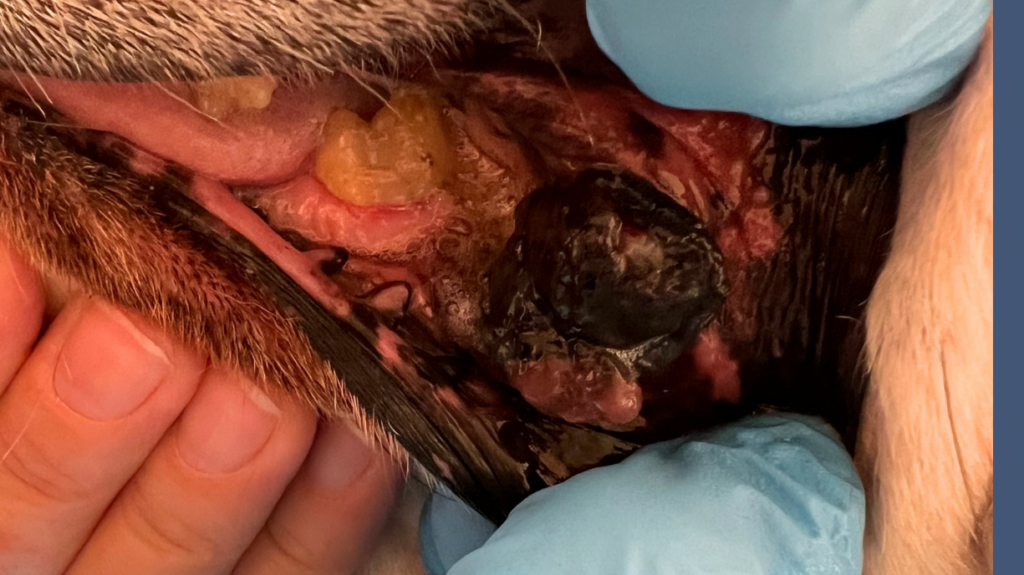Oral Melanoma
Case of the Month – March 2024
Stella, patient of Partner Oncology Richmond with Dr. Melissa L. Miller, Practice Limited to Oncology, Pet-Loss Grief Support Specialist (C) referred by Ashland Veterinary Hospital
Presenting Complaint and History:
Stella, a 13.5-year-old FS Beagle, was presented to Partner Oncology for further evaluation of a suspected oral melanoma. She was reported to have a left commissure pigmented oral mass identified incidentally on routine evaluation at Ashland Veterinary Hospital earlier in the month.

Exam Findings:
A non-sedated oral exam revealed moderate dental disease and gingivitis and a black pigmented, irregular, slightly pedunculated mass at the buccal mucosa of the left lip commissure measuring ~ 2.0 cm x 2.5 cm x 1.0 cm (see photo). No other oral masses were identified, and her tonsils were normal in appearance and within the tonsillar crypts. The left submandibular node was asymmetric to the right and slightly firm on palpation (~ 1.5 x 1.5 cm).

Diagnostics and Treatment:
Thoracic radiographs (3 views) were obtained for metastatic screening with unremarkable results. A complete blood count and biochemical profile were also performed in preparation for planned anesthesia. Given the amenable location of the oral mass for surgical excision, lymph node aspiration and cytology were discussed for staging but ultimately lymph node extirpation at the time of oral surgery for histopathology was elected for more definitive evaluation.
Mass excision and cheiloplasty with regional lymph node extirpation were performed with histopathology confirming a diagnosis of malignant melanoma with clean margins, mitotic count 7, and no metastasis to the regional lymph node identified. At time of surgery a 2-gram piece of tissue was frozen and submitted after diagnosis was confirmed to a company called Torigen for autologous vaccine formulation.
Vaccine therapy was started at the time of surgical recheck with additional vaccine administered subcutaneously once weekly for a total of 3 vaccinations. A monitoring plan for oral examinations and thoracic radiographs every 3 months for the first year was also discussed with the family.
Discussion:
Oral malignant melanoma (OMM) is the most common malignant oral tumor in dogs. While melanoma has been associated with UV light exposure in humans, the etiology of melanoma in dogs is largely unknown. OMM is locally invasive and has a high metastatic rate to regional lymph nodes (~ 70% of patients with lymphadenomegaly and 40% of patients with normal size lymph nodes will have metastatic disease at diagnosis), lung tissue, and many other sites. Therefore, the ideal treatment of choice is a combination of local therapy (surgery and/or radiation therapy) and systemic therapy (chemotherapy and/or immunotherapy in the form of melanoma vaccines).
Surgery is often the first step in therapy, to confirm a diagnosis and/or to provide local tumor control. If radical surgery is not a viable option, radiation therapy is often recommended in its place. Palliative radiation therapy is very effective for even large oral melanomas. Local tumor control is the first step, but the most important factor for many OMM patients is systemic cancer control.
Chemotherapy has historically been the systemic therapy of choice for most cancers, but melanoma tends to be more resistant to drug therapy than other cancer types. Patients with metastatic disease at the time of diagnosis, though, may benefit from chemotherapy. However, the goal is usually to slow normal cancer progression with response rates being variable.
In more recent years, targeted therapy has been investigated for the treatment of OMM in dogs. Genetic testing and targeted oral chemotherapy options are now available through a company called FidoCure.
Immunotherapy has been developed for the treatment of OMM and the results have been far more encouraging than with chemotherapy protocols, and this is currently the standard of care for OMM in dogs. Non-steroidal anti-inflammatory drugs have been reported to have benefits in 15% to 25% of patients who receive these medications.
Melanoma tumor vaccines, though, have been the most promising. Merial’s vaccine called ONCEPT is USDA-approved and reports median survival times of 1 to 1.5 years, even in patients with advanced stage disease. Autologous vaccines are also available from Torigen if fresh cancer tissue can be collected and sent for vaccine formulation.

Outcome:
Stella recovered uneventfully from surgery and tolerated her autologous vaccine injections without complications. Due to a concurrent history of arthritis and IVDD she was also prescribed an ongoing course of NSAID therapy (carprofen) as part of her melanoma management. Stella was last evaluated at Partner Oncology on January 25th, 2024 (6 months post diagnosis) with no visible local recurrence in her oral cavity, evidence of regional lymphadenomegaly, or pulmonary metastasis on thoracic imaging.
Take Home Points:
1. Oral malignant melanoma (OMM) is the most common malignant oral tumor in dogs.
2. Oral masses in older dogs may be incidental findings and oral evaluation should be encouraged at all routine veterinary visits.
3. Regional lymph-node sampling and thoracic imaging are key staging diagnostics for oral masses prior to treatment planning.
4. Immunotherapy is a core therapy for OMM management and autologous cancer vaccine therapy is a cost-effective and safe alternative systemic therapy to historic standardized treatment protocols.
If you have any questions about this case, please contact Dr. Miller at [email protected].
Subscribe to our get the Case of the Month straight to your inbox!
